On this page you will find information about the quality of the Maori symbolic pendants, the carvings and the materials they are made from. It also gives you information about Maori symbolism and the spiritual significance behind the Maori symbols.
The basic Maori design elements and Kowhaiwhai patterns and their meanings are well explained along with images. To understand more about these powerful and spiritual Maori symbols it is best to scroll along this entire page.
The pendant carvings Matariki offers you are genuine hand crafted New Zealand and Pacific bone carving, jade carving and pearl shell carving in its many forms, from the very traditional Maori carving styles to the more contemporary designs for gifts and jewelry.
Bone carvings
Bone carvings have a very special feel about them, unlike anything else you will ever experience. Their milky white appearance and soft flowing lines are just the start. They are soft and warm to the touch yet the finish is like polished glass, they seem to blend with your body and become a part of you, especially when worn as a pendent against your skin. Over a period of time bone carvings absorb oils from your skin and change colour to a very light honey gold. The Maori believe this to be the carving taking on some of your spirituality or essence and thus truly becoming a part of the wearer.
Each piece is hand crafted by New Zealand artists so even if following the same design, no two pieces will ever be exactly the same. Unique pieces in bone and pearl can also be designed and hand made especially for you, telling your story through traditional styling and some may also include exotic inlays of Paua or pearl shell.
Every carving comes with a traditional style braided or plaited wax cord, mostly with bound-in loop and toggle, along with a woven flax presentation bag or pouch, the Kete (Maori word for basket, bag) designed to show off the traditional styling and beauty of the carving, a care instructions sheet and a description of the meaning or story behind the design.
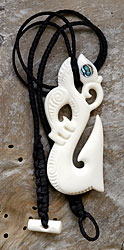
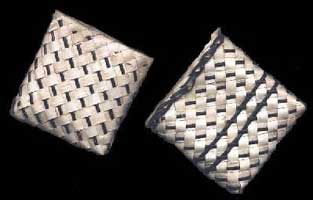
The length of the cords is such that the piece should sit in about the middle of the upper chest approximately 100 mm from the base of the neck. This makes the cord roughly 550mm in length when fitted to the carving.
If you would rather it sat higher more like a choker or want a specific length, please indicate the length required in your email when placing your order. There is no extra charge for custom making the standard cords to any length required, long or short. Note that if you specify a cord length the cord supplied will have a little extra to allow for fixing to the carving.
The small bag or pouch (called a "Kete" in Maori) that also comes with every carving is made from treated and woven native flax. It is again designed to compliment your carving and also provide protection when it is not being worn. The Maori have used the fibre from the hardy flax plant for hundreds of years to make bags, baskets, mats, clothing, ropes, bindings and even the walls of their huts. It is therefore the most appropriate way to present and care for a traditional or even contemporary bone, pearl or jade carving.
Blackfoot Paua. (Haliotis Iris)
The Blackfoot Paua is a type of Abalone shellfish, native to New Zealand and sourced mainly from its remote southern waters. The New Zealand Government protects the shellfish with a strict quota system relating to size and harvesting, but the fish can be eaten and is considered an expensive delicacy in many countries. Initially marine-encrusted, the shell is thoroughly buffed to reveal an amazing and unique array of multi colours, similar to mother of pearl but infinitely more iridescent. New Zealand Maori regard Paua as a magical gift from the sea that holds decision-making energies, increases intuition, sensitivity and imagination!
Paua pearls
Paua pearls are formed by inserting a seed beneath the mantle tissue of a paua. This is a delicate operation as paua are haemophiliacs. The paua then begins to overlay this nucleus with thousands of layers of nacre, conchiolin and calcite. It is these compounds which make up the iridescent mother of pearl. Only one paua in five produces a marketable pearl and only one in fifty a near perfect pearl. The pearl takes between 3 to 8 years to develop.
Pacific Pearl shell, or Mother-of-Pearl
Pacific Pearl shell, or Mother-of-Pearl, is a true treasure of the deep of the pacific ocean and is absolutely stunning when polished and carved. It has layers of gold or black through the silver/white pearl which seem to shift and swirl around as the carvings are turned. Pacific Pearl comes in gold lipped or black lipped varieties which often reach 10 inches or more in diameter and close to an inch thick. Pearl is almost as hard as jade so is a wonderful long lasting material intricate carvings.
Hematite
Hematite is a polished stone that is found in New Zealand's iron sand deposits. It is said to enhance personal magnetism, optimism and courage. Having a positive effect on the blood, hematite helps circulate oxygen throughout the body. It is therefore energizing and vitalizing.
Greenstone
Greenstone is a term specific to New Zealand to describe Jade. There are two types of Jade, jadeite and nephrite. Nephrite is the only type to occur in New Zealand. Jade comes in a variety of colors, green being the most valued. Jade / Greenstone is a hard and tough stone. It has been illegal to export raw jade / greenstone from New Zealand since 1947 due to it's limited supply.
In the early years Maori referred to Greenstone (Pounamu) as a fish that when removed from the river transformed itself into stone. Greenstone (Pounamu) thrives in water and when wetted reveals its clear innate beauty. A treasure (taonga) held in regard by New Zealand Maori, it has high spiritual significance and traditionally (and currently) used in a variety of forms. Worn in remembrance of passed ancestors (tipuna), the tiki was regarded as holding the power (mana) of the previous owners. Often worn as earrings (hei taringa) it was styled into the shape of a koru (shaped like whitebait - inanga) with a hole bored at the top for an eye and a suspension cord. Pendants including fishhook styles (hei matau) were worn and also used for catching food (kai). A strong and hardy material it was used for tools (toki), chisels (for building and decorating canoes (waka) and houses (whare) and for weaponry (mere) or club (patu). Te Waipounamu, the place of greenstone, is situated in the South Island of New Zealand.
Pounamu
Pounamu is a Maori word which is used to describe jade / greenstone and also bowenite. The Maori classified pounamu according to colour and named many varieties. Pounamu is broken down into 4 types: kahurangi, kawakawa, inanga and tangiwai.
Kahurangi is the rarest form of pounamu / greenstone. It is a light green greenstone with light streaks which resemble clouds. It is free of any flaws and is very translucent.
Kawakawa has a strong green colour with varying shades throughout. It is named due to the fact that it resembles a leaf from the kawakawa / Lofty pepper tree.
Inanga which means whitebait is a pearl white grey/green coloured stone which is usually translucent.
Tangiwai (Bowenite) is a very translucent, olive-green to bluish-green type of serpentine, found mainly at the entrance to Milford Sound in the South Island. The word tangiwai came from the Maori legend relating to the petrifaction of the tears of a lamenting woman. Sometimes it is referred to as koko-tangiwai, koko meaning ear pendant, and this signifies its predominant use.
Early Maori discovered Pounamu's ability to retain a hard, sharp edge making it ideal as cutting tools. Maori made adzes (toki) and chisels (whao) from nephrite jade, they fitted the jade to wooden handles and lashed them together using flax cords.
Pounamu / greenstone / Jade was normally suspended from thin leather or plaited flax. It was traditional for a piece to be worn level with the cavity where the two collarbones meet above the chest.
Maori Symbolism , Meanings and Patterns
The carvings based on Maori designs in particular have special significance. The pre-European Maori had no written language so tribal history and the stories of the gods were kept using many forms of fine arts and crafts ranging from basket and cloth weaving to complex wood, bone, shell and jade carving. These artefacts were then handed down through generations of tribal elders and became sacred objects or treasures "Taonga", telling the history of a tribe and taking on the spirits of past great leaders and warriors who had worn them.
It is believed that a carving which is worn with respect or given and received with love, takes on part of the spirit of those who wear or handle it. In this way it becomes a spiritual link between people spanning time and distance. A carving that has been worn by family or tribal members over many generations contains the spirit of all of those people and is truly a great and powerful treasure.
Therefore it is also believed that a greenstone pendant should be given to a special person and not to buy it for yourself as this is tapu (sacred) to be giving it to someone who has earned it. Therefore it is not done to give it to yourself.
Pendants, jewelry and various tools such as needles, spear tips and fish hooks made from bone developed into a fine art form with great importance being placed on every piece, many of which took years to make using stone tools. Some have inlays of precious stones or colourful shell and all have a story or meaning behind their design.
The Maori have a great respect for nature and have many legends about the creation of the earth and all its inhabitants. Many of these legends revolve around the spirits or gods who created or protect each part of their world such as the mountains, the forests, the lakes and the creatures of the sea.
Most carvings combine elements from several areas of mythology which interact with each other to tell a story. Each element has its own specific meaning and the way they are portrayed or combined is what gives a carving its own special character. The meanings of some elements vary from region to region but all share common roots.
Basic Design Elements and Their Meanings
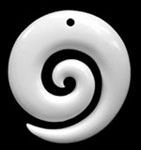 |
Koru The spiral is a Koru, represents the fern frond as it opens bringing new life and purity to the world. It also represents peace, tranquility and spirituality along with a strong sense of regrowth or new beginnings. The Koru is also often associated with nurturing so when interlocked with others is frequently used to represent the strength and purity of a loving relationship within a family. |
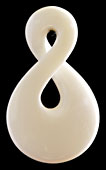 |
Twist The twist with its crisscross form represents the many paths of life and love and as such is regarded as the original eternity symbol. The single twist in particular shows the joining together of two people for eternity. Even though they sometimes move away from each other on their own journeys, they will always come together again sharing their lives and blending to become one. It tells how the strength of bond of friendship, loyalty and love will last forever. The double and triple twists have a similar meaning but refer more to the joining of two peoples or cultures rather than individuals. They also refer to the three baskets of knowledge. |
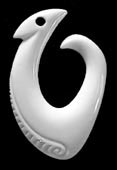 |
Hei-Matau These very stylised fish hooks represent strength, prosperity, abundance, fertility and a great respect for the sea. It also is said to provide good luck and safety when traveling over water so is often worn by travelers. Hei-Matau are also symbols of power and authority which are held in great reverence by the Maori people. They were used as a practical tool for fishing and were often decorated as a sign of respect for the creatures of the sea. There are many styles of Hei-Matau from the true hook designs to the more ornamental styles which became treasured heirlooms for generations following. |
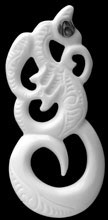 |
Manaia: The Manaia is an ancient mythical being with a birds head and a human form. It is said to be the messenger between the earthly world of mortals and the domain of the spirits illustrating the strong links the Maori people have with spirituality and the spirit world. It is a holder of great spiritual energy and is a guardian against evil. The Manaia can be seen blended into many Maori designs with subtle differences between tribes. The Manaia is often depicted with the three fingers of birth, life and death. It can also be shown with a fourth finger representing the afterlife and describing the circle of life. |
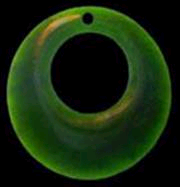 |
Circle The closed circle is said to represent the circle of life which is has no beginning or end, is seamless and of which we are all a part. It also tells of the stars and planets which are part of the circle of life and contain the knowledge of our origins. It is often used to enclose other elements such as the Koru, linking love and new life or new beginnings with the circle of life. For an artist the circle represents the relationship or oneness between the artist and his craft, bringing together head, hand and heart. |
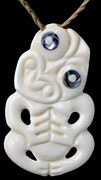 |
Tiki The Tiki is a very ancient symbol and is by far the least understood so there are a number of legends about its meaning. Some say he came from the stars and that he was the first man of the world. He is also often depicted with webbed feet which suggests a strong link to the creatures of the sea. Tiki was respected as the teacher of all things and the wearer of this symbol is therefore seen to possess clarity of thought, loyalty, great inner knowledge and strength of character. The Tiki is regarded as a good luck charm when worn and in some areas is also regarded as a fertility symbol. |
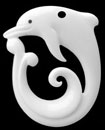 |
Whales, Dolphins and Turtles The ocean has always been the dominant force for the Maori people who traveled huge distances in their long canoes and lived on the bounty of the tropical waters. They had a great respect for the creatures on the sea and in particular dolphins and whales. The whale with its great size and obvious intelligence played an important part in the culture of the Maori people. They were often represented as an example of family love with mother and calf always side by side and touching at every opportunity. Beached whales were treasured as gifts from the gods. They were particularly prized for the bone which after several years of curing was used to carve ornate jewelry and art works, often passed down for many generations. A dolphin is s symbol of playfulness, harmony and friendship while the turtle is the sign of a navigator. |
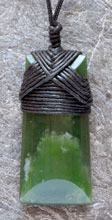 |
Toki The Toki (Adze) was used as a tool on a daily basis by the Maori. Because the Greenstone (Pounamu) was so tough the Maori used it for several tools, chisels en adzes (Toki) to build and decorate their canoes (Waka) and houses (Whare) but also for their weapons such as the Mere (Maori club). The traditional bound version of this Toki pendant shows an exact replica in the way this tool was used and carried in former times. Or as it was bound on a wooden handle (Toki Pou Tangata). |
  |
Mere and Patu The Maori people being fierce warriors used a wide range of hand weapons. The most common were short spears (Taiaha) used more like a sword and clubs used in hand to hand fighting. The clubs were made of many materials including wood, stone, jade and bone. Mere (clubs) were used by the great warriors and leaders and were made from the rare New Zealand nephrite Jade (Pounamu) and handed down over generations as treasured heirlooms. The Mere is not just the symbol of a warrior, but also of a great leader. Tribal leaders are generally the greatest of warriors but with the power of leadership also comes a responsibility to care for those who follow. Patu are Maori clubs carved from native New Zealand wood. This carving speaks of a leader who has great inner strength and courage but who cares for and nurtures those around him or her with wisdom and respect. |
 |
Waka: The Waka is commonly known as a canoe but in reality Waka means "Sacred Vessel". The Maori long canoes were very sacred and carried the spirits of the warriors and chiefs who carved and used them. Waka or carved wooden containers (Wakahuia) were also used for storing sacred items such as ceremonial Huia feathers, bone needles and spear tips, and also carvings. The great war canoes are actually Waka Taua, outrigger canoes are Waka Ama, Ocean going canoes are Waka Tete and your true home or place of origin is Wakaianga. The abstract canoe shaped Waka as a carving and pendant represents a sacred vessel for the spirit when touched, gifted or worn by family and friends. It is a way of having part of the spirit of a loved one with you when you are away from that person and the canoe shape itself also represents travel. |
 |
Drop Pendants : These simple yet elegant forms of these Jade drop pendants feature the stunning diversity of New Zealand Jade (Pounamu) from rich greens and swirling patterns to the vibrant colours of the rare Flower Jades of the Marsden district. All drop pendants are regarded as touch stones for meditation and are representing a connection to the whenua (the land) Aotearoa (New Zealand). Each shape also has additional meanings relating to the wearer. - Long Slender Drops (Kuru): Helps encourage knowledge, confidence and independence. - Squares and Rectangles: A guide or mentor bringing a solid grounding and reliability to others. - Teardrops and ovals (Roimata): Positive energy, healing and comfort. - Short Drops: Strength, confidence, loyalty and pride. - Triangle: Representing independence, creativity and spiritual clarity. |
Different types of Kowhaiwhai (repeatedly used Maori patterns in carvings and paintings)
With thanks to www.maori.org.nz who agreed we used the images below.
| Kaperua | Koiri | Mangopare |
| From the Tai Rawhiti | From the Tai Rawhiti | From Aotearoa. |
 |
 |
 |
| This pattern represents things doubled. | This pattern means to flourish. | This design comes from the hammerhead shark and represents strength and power. |
| Mangotipi | Ngaru | Patiki |
| From Mataatua, Tuhoe. | From Ngati Kahungunu | From Pare Hauraki |
 |
 |
 |
| This design comes from the white pointer shark. | This design represents the cutting of the waves when the waka travelled. | The design represents the Patiki or flounder. It is a symbol of hospitality. |
| Puhoro | ||
| From Te Arawa | ||
 |
||
| This design represents speed, swiftness and agility |
Other special meanings of Maori carvings
With thanks to www.maori.org.nz who agreed we used the images below.
| Unaunahi or Unahi | Rauru | Raperape |
| From the Tai Tokerau | From the Tai Rawhiti, Ngati Tuwharetoa, Waikato and Tai Hauraki. | From Aotearoa. |
 |
 |
 |
| This pattern represents fish scales. It is mainly done in the Tai Tokerau area and is carved to represent abundance of food, wealth of the sea and people. | This is the most common form of this pattern and is also common in Uhi Moko, used on the buttocks. | This design is carved to represent movement. It is used by all areas of Aotearoa and stands for continuity towards our evolving future. |
| Maui | Rauponga | Whakarare or Korurangi |
| From Tai Rawhiti, Te Arawa and Te Waipounamu. | From Ngati Porou, Ngati Kahungunu, Te Arawa and Waikato. | From Aotearoa |
 |
 |
 |
| Because of the shape of this design it represents the fish hook of Maui. | This design is used on the body of figures to represent the ribs of the ancestor. The design is from the leaf of the fern. | The design is used in most carvings to show movement and experience |

















